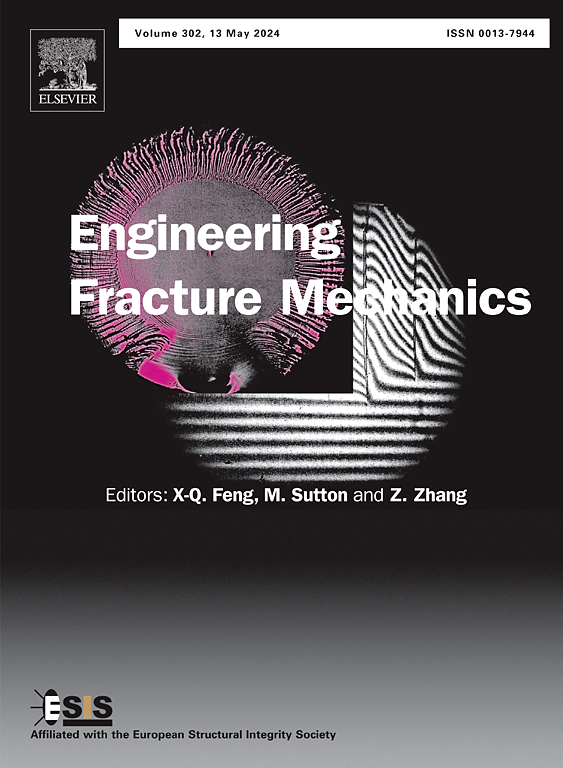密闭空间水射流冲击下高温花岗岩的断裂和分形特征
IF 4.7
2区 工程技术
Q1 MECHANICS
引用次数: 0
摘要
在射流辅助深孔钻进技术的应用中,高温岩石在射流钻进受限空间内的断裂模式和岩石碎屑特征尚不明确。我们利用三维重建技术和统计分形理论分析了高温花岗岩在密闭空间射流作用下的碎裂和碎屑分布,研究了其碎裂模式和分形特征。结果表明,高温岩石在约束水射流的冲击下表现出明显的热断裂特征,随着岩石温度的升高,垂直压缩剪切裂缝与径向拉伸裂缝相连。最大破坏区域位于约束孔底部附近,裂缝分布较为复杂。随着喷射密闭程度的降低,岩石开裂形式由径向拉伸裂缝转变为垂直压缩剪切裂缝。随着岩石温度的升高和封闭空间尺寸的减小,岩石碎屑的总质量和大块碎屑的质量百分比都会增加。岩石碎屑的粒度分布遵循罗辛-拉姆勒(R-R)分布,具有明显的分形特征。高温岩石在约束水射流冲击下的断裂和破碎主要是由水射流冲击应力波和热应力共同作用造成的。岩石的温差影响射流与岩石之间的传热,密闭空间大小直接影响射流与岩石之间的传热效率,表现为不同的断裂裂纹数量、内部损伤面积和岩石碎屑大小分布。这些发现可为射流辅助深层储层钻井应用提供理论和参数优化依据。本文章由计算机程序翻译,如有差异,请以英文原文为准。
Fracture and fractal characteristics of high-temperature granite under confined space water jet impact
In the application of jet assisted deep drilling technology, the fracture mode and rock fragment characteristics of high-temperature rock in the confined space of jet drilling are not yet clear. We analyzed the fragmentation and debris distribution of high-temperature granite under confined space jet action using 3D reconstruction technology and statistical fractal theory to examine their fragmentation patterns and fractal characteristics. The results show that high-temperature rocks exhibit obvious thermal fracturing characteristics under the impact of confined water jet, and as the rock temperature increases, vertical compression shear cracks connect with radial tensile cracks. The maximum damage area is located near the bottom of the confined hole, and the distribution of cracks is more complex. As the degree of jet confinement decreases, the rock cracking form changes from radial tensile cracking to vertical compression shear cracking. As the rock temperature increases and the confined space size decreases, the total mass and large debris mass percentages of rock debris increase. The particle size distribution of rock debris follows an Rosin-Rammler (R-R) distribution and has obvious fractal characteristics. The fracture and fragmentation of high-temperature rocks under confined water jet impact are mainly caused by the combination of jet impact stress waves and thermal stress. The temperature difference of rocks affects the heat transfer between jet and rock, and the confined space size directly affects the heat transfer efficiency between jet and rock, which is manifested in different numbers of fracture cracks, internal damage area, and rock debris size distribution. These findings can provide a theoretical and parameter optimization basis for jet-assisted deep reservoir drilling applications.
求助全文
通过发布文献求助,成功后即可免费获取论文全文。
去求助
来源期刊
CiteScore
8.70
自引率
13.00%
发文量
606
审稿时长
74 days
期刊介绍:
EFM covers a broad range of topics in fracture mechanics to be of interest and use to both researchers and practitioners. Contributions are welcome which address the fracture behavior of conventional engineering material systems as well as newly emerging material systems. Contributions on developments in the areas of mechanics and materials science strongly related to fracture mechanics are also welcome. Papers on fatigue are welcome if they treat the fatigue process using the methods of fracture mechanics.

 求助内容:
求助内容: 应助结果提醒方式:
应助结果提醒方式:


